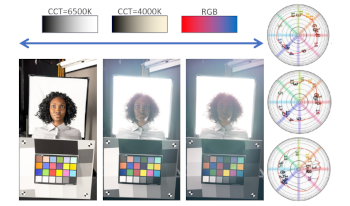
This article provides elements to answer the question: how to judge general stylistic color rendering choices made by imaging devices capable of recording HDR formats in an objective manner? The goal of our work is to build a framework to analyze color rendering behaviors in targeted regions of any scene, supporting both HDR and SDR content. To this end, we discuss modeling of camera behavior and visualization methods based on the IC T C P /ITP color spaces, alongside with example of lab as well as real scenes showcasing common issues and ambiguities in HDR rendering.


In previous work [1] , content-color-dependent screening (CCDS) determines the best screen assignments for either regular or irregular haltones to each image segment, which minimizes the perceived error compared to the continuous-tone digital image. The model first detects smooth areas of the image and applies a spatiochromatic HVS-based model for the superposition of the four halftones to find the best screen assignment for these smooth areas. The segmentation is not limited to separating foreground and background. Any significant color regions need to be segmented. Hence, the segmentation method becomes crucial. In this paper, we propose a general segmentation method with a few improvements: The number of K-means clusters is determined by the elbow method to avoid assigning the number of clusters manually for each image. The noise removing bilateral filter is adaptive to each image, so the parameters do not need to be tested and adjusted based on the visual output results. Also, some color regions can be clearly separated out from other color regions by applying a color-aware Sobel edge detector.





The colors of Van Gogh’s landscape painting Field with Irises near Arles have changed considerably. To digitally reconstruct its original colors, we use an unprecedented broad scientific analysis and experimental art technological approach, by physically reconstructing oil paints of all pigments used by Van Gogh. We closely match the original paints, and for the first time determine all the optical properties involved. The investigation led to a digital image representing the original colors as good as possible.We found that for the digital color reconstruction it is important to take into account that museum lighting is often relatively dark in order to better preserve paintings. Since this affects the best way of representing the reconstructed colors on the display, we adapted the digital reconstructed image. We also corrected for the technical specifications of the electronic display on which the reconstructions will be displayed in the museum.Based on the reconstruction we conclude that the original colors in the painting used to be much brighter, and agreed much better with Van Gogh’s own description of the color composition of this painting. We show that unlike the current colors of the painting, the reconstructed colors are consistent with the color theories on which Van Gogh based his work.

Glare is an unwanted scattering of light occurring upon its propagation through optical media, whose scarcely predictable, scene-dependent effects are potentially disrupting in terms of accurate scene acquisition. This work starts from the idea of assessing the magnitude of glare in low dynamic range monitor layers during visualization. According to common practice, monitor dynamic ranges are computed as ratios of maximum to minimum luminance values separately acquired on full-screen black and white images. Avoiding the coexistence in the same image of maximum and minimum luminance, this method does not consider the effect of possible intralayer glare. To measure possible intra-layer glare in a monitor, we have displayed images made up with black and white patterns of different sizes. Measuring these different patterns, we detected changes in the luminance of the black regions. At first we explained data as a glare effect. Measuring more carefully each regions through a masking cardboard with a hole, these differences were no more there. It was just glare, not from the monitor layers, but from the lens of the measuring instrument. To further investigate the issue, another setup was arranged whereby two color checkers were stationed behind a dimmable light source aiming away from them both, and directly into the luminance meter. We found that despite light being unable to fall directly on the color checkers, an increase of radiant power was paralleled by an upward drift in luminance values for all examined spots, more so for those lying the closest to a prominent lens flare within the device viewing field. These combined findings show us that no matter the accuracy of the measuring device, luminance information can neither be measured nor displayed correctly in the presence of glare in the instrument.
